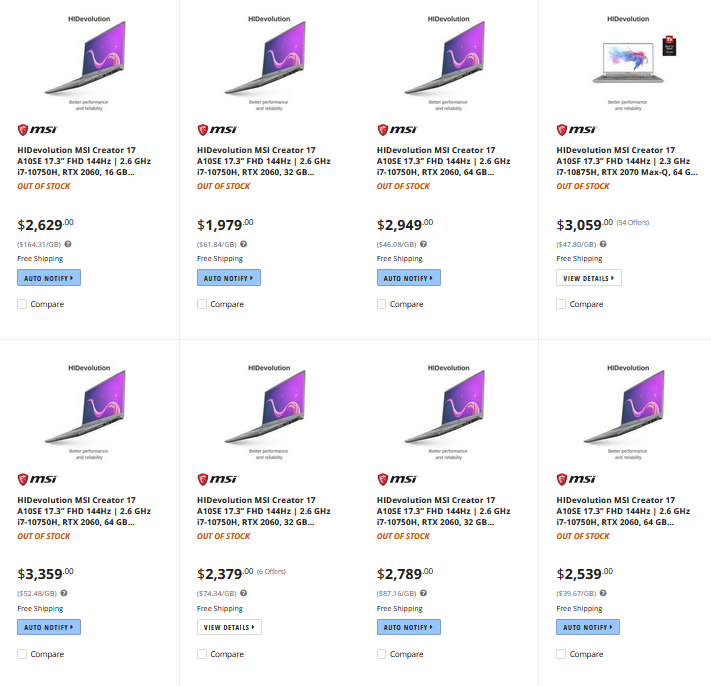Melting laptops will be the new trend. Or laptops with cup holders to keep your coffee hot
I've explained this before. The reason that we're "against boosting", in this scenario, is because it's simply not going to happen. Nobody cares if a laptop boosts to 5.3GHz for a fraction of a second, before power or thermal limits kick in, to load a word document or a web page 1/10 of a second faster than it would have if it just ran at base clock all the time. As such, the feature is useless... and who wants features that don't work? No, we don't get a working feature... instead we get "5.3GHz!!111!111" plastered everywhere, when in reality it can only reach that speed for a very short time, i.e. applications where 5.3GHz performance isn't necessary anyway.
Now, take that same chip and put it in a desktop where power and thermal limits aren't woefully constrained like they are in a laptop, and you get a different story. Nobody complains about the 9900k boost clock, because it can actually reach it. Nobody complains about the boost feature on Nvidia graphics cards, because they actually do it. People complain about the advertised boost clocks on these laptops, because they don't do it. That's the key difference.
Have you also explained that more clocks and smaller die sizes that "are plastered everhwere" do not increase gaming performance ? ... or in pretty much everything else 98+% of what people do on a daily basis ? Why are cores and die size relevant when TPU testing shows CPU overclocking is relevant. Sure, if you are a user trying to game on a 3.5 pound ultralight but again, on a properly designed and preferabley custom built lappie, no problem. There's a very active overclocking community on the Clevo website with lapped CPUs, delidding, cooler mods and high sustainable OCs from simple things to extreme. Before Alienware was bought by Dell, they were simply Clevo custom built laptops.
When you say "Nobody complains about the 9900k boost clock, because it can actually reach it.", you should be aware that the fact is custom built laptopss have the option of using desktop CPUs 9900k so nobody should be complaining by your reasoning. The cooling systems are designed to handle the load.
Clevo P775TM1-G 17" Laptop
9th Generation Intel® Core™ i9-9900K Processor (16M Cache, up to 5.00 GHz)
17.3" Full HD 144Hz Wide View Angle 72% NTSC Matte with G-SYNC Technology
NVIDIA® GeForce™ RTX™ 2080 GPU with 8GB GDDR6
32GB Dual Channel DDR4 3000MHz (PC4 24000) - 2 X 16GB
Windows® 10 Pro 64-Bit Edition Preinstalled, (with 64-Bit USB Recovery Media)
Thermal Grizzly Kryonaut Thermal Compound - CPU + GPU
1TB SAMSUNG® 970 PRO™ M.2 PCIe NVMe V-NAND SSD (OS DRIVE)
1TB SAMSUNG® 970 PRO™ M.2 PCIe NVMe V-NAND SSD (SLOT 2)
SAMSUNG® 860 PRO™ 4TB SATA III 3-D Vertical SSD
Intel® Wi-Fi 6 AX200 M.2 AX + Bluetooth® 5 Combo Card
Clevo PB71RF-G
9th Gen Intel® Core™ i7-9750H Processor (12M Cache, up to 4.50 GHz)
17.3" Full HD (1920 x 1080) 144Hz, Wide View Angle 72% NTSC Matte with G-SYNC Technology
NVIDIA® GeForce™ RTX™ 2070 with 8GB GDDR6 Video memory
32GB Dual Channel DDR4 3000MHz (PC4 24000) - 2 X 16GB
Thermal Grizzly Kryonaut Thermal Compound - CPU + GP1TB SAMSUNG® 970 PRO™ M.2 PCIe NVMe V-NAND SSD (OS DRIVE)
1TB SAMSUNG® 970 PRO™ M.2 PCIe NVMe V-NAND SSD (SLOT 2)
SAMSUNG® 860 PRO™ 4TB SATA III 3-D Vertical SSD
Intel® Wi-Fi 6 AX200 M.2 AX + Bluetooth® 5 Combo Card
Should also be aware that the performance difference between mobile and desktop CPUs / GPUs has considerably narrowed. Let's look at some numbers:
Card: Ranking - 3D Mark Ice Storm / 3D Mark Cloud Gate / 3D Mark Firestrike
NVIDIA GeForce RTX 2070 (Desktop) : Ranked 20th - 424385 / 126874 / 23373
NVIDIA GeForce RTX 2070 (Mobile): Ranked 23rd - 425550 / 116232 / 20036.5
Gaming performance as tested, ranges from 119 desktop / 118 mobile (Escape from Tarkov) to 184 / 154 (Doom Eternal)
Imagine that ... only 2 GPUs in the world faster than the 2070 Mobile and slower than the 2070 desktop... GTX 1080 and RTX 2070 Super.
We have been buying Clevo laptops exclusively for, I'd guess, going on 20 years ...1) because nothing we've found performs better, 2) unequal freedom in component selection, 3) no artificial limitations on performance tweaking and 4) less expensive than gaming laptops from MSI. After installing OS / running RoG Real Bench and Furmark is the 1st thing done and when I put the effort in, have even managed to get a notable OC.





